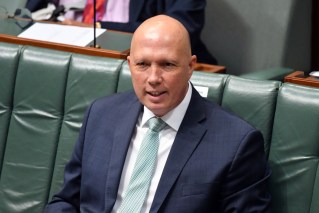Michael Pascoe: Easy money driving housing boom, with more to come


Michael Pascoe says banks have been kissed on the backside by a rainbow.
The best kind of prophesies to make are the self-fulfilling kind – they have most chance of being right.
So it is with banks competing to make the most bullish forecasts for housing prices – the forecasts themselves are helping to drive prices higher.
The banks making the predictions also are more aware than anyone what sort of deposits are sitting in customers’ accounts, how much easier they have made it to borrow more, and that lending standards are about to be further loosened.
When your bank tells you housing prices will rise by 20 per cent over the next two years (as Westpac did last month while you have money sitting in the bank earning two-fifths of stuff-all and said bank will be absolutely delighted to lend you a larger sum without looking as closely at your spending history as they had been, well, what’s that real estate agent’s number?
The banks themselves have been kissed on the backside by a rainbow, having made much bigger provisions for bad debts last year than it turned out they needed.

Bullish bank forecasts about housing are helping to drive prices higher. Photo: TND
They have turned the economic corner with spare cash, nothing happening in the way of business lending, and the Reserve Bank inviting them to take as much as they can carry out of its Martin Place vault and throwing in an official blessing for a housing price boom.
Thus executive bonuses this year will come from pushing as many residential mortgages out the door as possible. Come and get it.
Too bad that the short-term boom contains the seeds of significant trouble down the track. I’ll come back to that.
First though, the feedback from mortgage brokers is that money is indeed flowing much more freely – and that’s ahead of the government’s plan to further water down responsible lending rules at the end of this month. (I’m probably in the minority of commentators who think individuals have the right to take a lending risk, but there’s extra danger during a lending frenzy.)
Property consultant and commentator Michael Matusik’s latest newsletter reports a conversation with an anonymous mortgage broker who fingered contributing factors including the impact of banks reducing their hurdle rate for loans, reversing the greater caution they adopted last year as the pandemic unfolded, and changing their attitude to including superannuation withdrawals as part of “savings”.
The super withdrawals that were supposed to be for alleviating hardship can now be used as part of a deposit “with some low-level caveats”. Tim “Franking Credits” Wilson must be delighted with that contribution to higher prices.
According to the anonymous broker, the move last year to lower the interest rate used for assessing a loan’s serviceability means “a household’s income needs now to only be $70,000 per annum compared with $110,000 to afford a $450,000 house”.
I put the allegations to Loan Base principle mortgage broker Chris Gillis. He disagreed with some of the detail but backed the thrust as lenders have been unwinding conservative policies adopted as the pandemic hit.
“Some lenders stopped lending to people working in certain industries – tourism, aviation, hospitality – and some stopped lending to people who had applied for COVID-19 government assistance such as JobKeeper,” Mr Gillis said.
“Lenders began requiring more documentation than was previously needed to confirm that income had not been affected by COVID and many lenders increased their degree of shading for certain types of non-base income – bonus, overtime, commission, rent.”
Most lenders implemented policy not to allow borrowers to count COVID-19 super withdrawals as genuine savings. Now most of those policy changes have been reversed.
“Even borrowers applying for a high loan-to-valuation loan would likely be able to use funds withdrawn from super towards a purchase, so this could contribute to the property market heating up, but I wouldn’t think that it would be a significant factor.”
Mr Gillis said lenders were using an assessment rate of 7.25 per cent until APRA removed its 7 per cent floor rate in July 2019.
Since then, most were using the higher of the actual borrowing rate plus a 2.5 per cent buffer or a floor rate generally between 5 and 6 per cent.
The floor rate had limited the increase in borrowing power. He gave the example of a single individual on a $70,000 salary with no other debt being judged able to service a $400,000 loan.
“With the lower current assessment rate of 5.75 per cent, same client’s borrowing power would now be $480,000.”

Relaxed lending standards has potential to make the property market overheat.
Mr Gillis said the bank economists’ forecasts of strong housing price growth were contributing to a sense of FOMO (fear of missing out) for many borrowers.
Along with general sentiment turning more positive, low interest rates, funds saved while being more conservative last year, he also cited customers seeming to value a larger home more highly.
On top of plenty of demand and cheap money looking for a home, Matusik writes that supply is tight, influenced by COVID restrictions.
“The media echo chamber has added further demand momentum, headlining positive property media releases, in part to help boost reader traffic to their real estate digital advertising portals,” he says.
“As a result, buyers are clamouring to get into the market, evident by recent weekend auction clearance rates of over 90 per cent.
“This might be good news for those households that own their home, either outright or with a mortgage. However, it may not be so good for those trying to get into the housing market.”

Housing affordability in the longer term remains an issue.
And then there’s the little problem of the boom not lasting.
Mr Matusik rounds up the usual suspects: Persistent high unemployment and underemployment; lower population growth through the collapse of immigration and the falling birthrate; potential overbuilding due mostly to HomeBuilder; rising building costs; supply increasing; and then there’s the big one – weak wages growth.
“Limited wage growth is the big brake on substantial dwelling price growth.
“There is a close, long-term relationship – causation not correlation – between wage growth and dwelling value increases in Australia.
“I cannot see how future first-home buyers will be able to service such high dwellings prices given low wage growth. Borrowing the difference only has a limited shelf life.”
And this is all without getting into the impact of increasing inequality and the damage that does to both a nation’s economy and society.
Enjoy your officially sanctioned boom if you’re among the fortunate ones – while it lasts.








